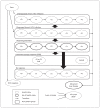Cost-effectiveness of screening for hepatitis C in Canada
- PMID: 25583667
- PMCID: PMC4330166
- DOI: 10.1503/cmaj.140711
Cost-effectiveness of screening for hepatitis C in Canada
Abstract
Background: The seroprevalence of hepatitis C virus (HCV) infection among Canadians is estimated at 0.3% to 0.9%. Of those with chronic HCV infection, 10% to 20% will experience advanced liver disease by 30 years of infection. Targeted screening seems a plausible strategy. We aimed to estimate the health and economic effects of various screening and treatment strategies for chronic HCV infection in Canada.
Methods: We used a state-transition model to examine the cost-effectiveness of 4 screening strategies: no screening; screen and treat with pegylated interferon plus ribavarin; screen and treat with pegylated interferon and ribavarin-based direct-acting antiviral agents; and screen and treat with interferon-free direct-acting antivirals. We considered Canadian residents in 2 age groups: 25-64 and 45-64 years of age. We obtained model data from the literature. We predicted deaths related to chronic HCV infection, costs, quality-adjusted life-years (QALYs) and incremental cost-effectiveness ratios.
Results: We found that screening and treating would prevent at least 9 HCV-related deaths per 10,000 persons screened over the lifetime of the cohort. Screening was associated with QALY increases of 0.0032 to 0.0095 and cost increases of $124 to $338 per person, which translated to an incremental cost-effectiveness ratio of $34,359 to $44,034 per QALY gained, relative to no screening, depending on age group screened and antiviral therapy received.
Interpretation: A selective one-time HCV screening program for people 25-64 or 45-64 years of age in Canada would likely be cost-effective. Identification of silent cases of chronic HCV infection and the offer of treatment when appropriate could extend the lives of Canadians at reasonable cost.
© 2015 Canadian Medical Association or its licensors.
Figures
References
-
- Kwong JC, Crowcroft NS, Campitelli MS, et al. Ontario burden of infectious disease study. Toronto: Institute for Clinical Evaluative Sciences; 2010.
-
- Recommendations for the identification of chronic hepatitis C virus infection among persons born during 1945–1965. MMWR Recomm Rep 2012;(RR-4):1–32. Erratum in: MMWR Recomm Rep 2012;61:886. - PubMed
-
- Asselah T, Marcellin P. Direct acting antivirals for the treatment of chronic hepatitis C: one pill a day for tomorrow. Liver Int 2012;32 Suppl 1:88–102. - PubMed
Publication types
MeSH terms
Substances
LinkOut - more resources
Full Text Sources
Other Literature Sources

